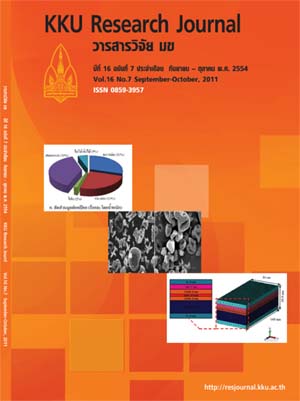Effectiveness of health education media (handbook and VCD) for OV preventing on primary school students
Main Article Content
Abstract
This quasi-experimental research was aimed to study the effectiveness of a handbook and a VCD as the educational tools for liver fluke prevention among primary school students in 4 schools in Phu Wieng district, Khon Kaen province, Thailand. The samples of 152 subjects were divided into two groups; the first experimental group included 82 subjects who received health education about liver fluke prevention using a handbook and the second experimental group included 70 subjects who received health education about liver fluke prevention using a VCD. Data were collected by using questionnaires and analyzed by the STATA program. The statistics for the descriptive data included percentage, distribution, arithmetic mean and standard deviation. Comparisons between and within groups were made using paired sample t-test and independent sample t-test. The results showed that after implementation, both experimental groups had significantly higher mean score in 3 factors namely knowledge, attitude and perceived susceptibility (p<0.001), while perceived benefit and perceived barrier in first experimental group had significantly higher mean score than before (p<0.001) as well as perceived severity in the second group had significantly higher mean score than before (p<0.001). In both group, liver fluke prevention practice had significantly higher mean score than before (p<0.05 and p<0.005, respectively). In addition, the difference in mean score between the first and second experimental groups was not significant except perceived susceptibility and perceived benefit (p<0.001) but both were at a high score level. Both groups of students agreed that both media handbook and VCD were useful. For using the handbook, students needed to read and clearly understand and for using the VCD, they needed assistance from a teacher. The examination for parasites found that there were 18 infections, including 14 for liver flukes (11.48 percent) and a few other parasites. This research suggests that both media were effective to behavior change on liver fluke prevention. Therefore, these media should be published and further used for liver fluke prevention.
Article Details
How to Cite
Sota, C., Sithithaworn, P., Duangsong, R., & Three-Ost, N. (2017). Effectiveness of health education media (handbook and VCD) for OV preventing on primary school students. Asia-Pacific Journal of Science and Technology, 16(7), 899–910. Retrieved from https://so01.tci-thaijo.org/index.php/APST/article/view/83603
Section
Research Articles

